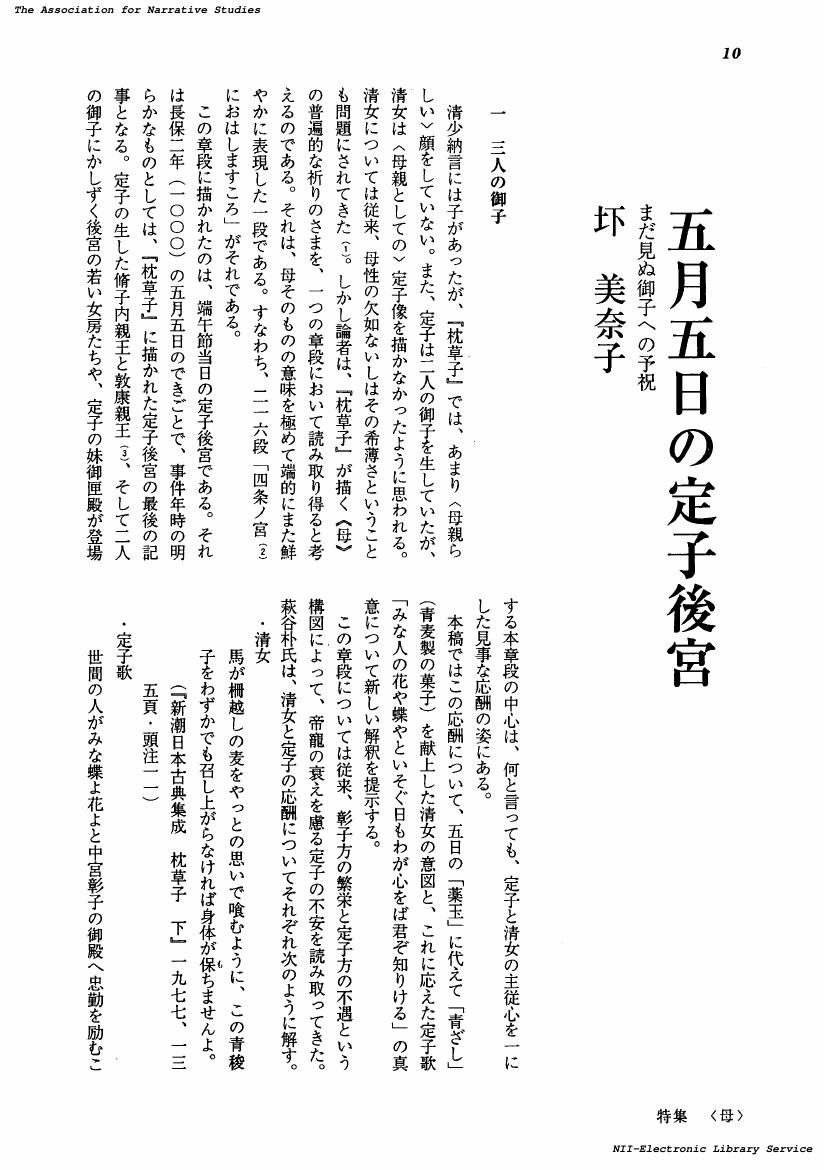26 0 0 0 OA 『枕草子』「長徳の変」関連章段の解釈 ―後宮の視点によって描かれた政変―
- 著者
- 圷 美奈子
- 出版者
- 中古文学会
- 雑誌
- 中古文学 (ISSN:02874636)
- 巻号頁・発行日
- vol.71, pp.12-22, 2003-05-30 (Released:2019-05-18)
4 0 0 0 OA 『枕草子』「中納言殿まゐらせたまひて」の段をめぐって
- 著者
- 圷 美奈子
- 出版者
- 中古文学会
- 雑誌
- 中古文学 (ISSN:02874636)
- 巻号頁・発行日
- vol.55, pp.20-30, 1995-05-20 (Released:2019-05-18)
2 0 0 0 OA 『枕草子』「雪山の段」を読み解く ――和歌をめぐる新しい解釈――
- 著者
- 圷 美奈子
- 出版者
- 日本文学協会
- 雑誌
- 日本文学 (ISSN:03869903)
- 巻号頁・発行日
- vol.62, no.1, pp.72-75, 2013-01-10 (Released:2018-01-31)
2 0 0 0 「枕草子」の研究 : その同時代的表現をめぐる考察
2 0 0 0 OA 五月五日の定子後宮 : まだ見ぬ御子への予祝(<特集>母)
- 著者
- 圷 美奈子
- 出版者
- 物語研究会
- 雑誌
- 物語研究 (ISSN:13481622)
- 巻号頁・発行日
- vol.3, pp.10-25, 2003-03-31 (Released:2018-03-27)
1 0 0 0 OA 『枕草子』の注釈史研究-享受史復元の試みとして-
- 著者
- 圷 美奈子
- 出版者
- 和洋女子大学
- 雑誌
- 若手研究(スタートアップ)
- 巻号頁・発行日
- 2008
明治期までの『枕草子』解釈史の中から、昭和期に起きた使用底本の切り替え等によって、本文と同時に切り捨てられてしまった部分をすべて拾い出し、古注釈と現代注の見解の関係について整理する作業を行った。『枕草子』について一度は断絶し、読みの歴史から失われてしまった「享受史」を復元する研究により、各章段・場面に関する新しい解釈の成果を得るとともに、現代における『枕草子』研究の問題の本質と課題とが明らかになった。
- 著者
- 圷 美奈子 アクツ ミナコ Minako Akutsu
- 雑誌
- 和洋女子大学紀要. 人文系編
- 巻号頁・発行日
- no.48, pp.33-48, 2008-03
- 著者
- 圷 美奈子
- 出版者
- 物語研究会
- 雑誌
- 物語研究 (ISSN:13481622)
- 巻号頁・発行日
- vol.8, pp.20-32, 2008-03-31 (Released:2018-03-27)
The 31-syllable Japanese poems can express not only real scenery and feeling. Surely, to express the ideal world by the poems led great progress of Japanese expression. The technique "mitate" is one of the most impotant expressions. But the matter to be examined by this paper is different from "mitate" which is typical arts of "the Kokinshuu" for example to watch snow as a flower. By this paper, I will point it out about the art of poems which was not noticed till now. It is expression to replace reality with other matters. It may be said that it is a kind of technique of so-called "mitate." However, it is not the figurativ expression. It is the technique to express the matter that you should express definitely. In other words the technique of expression concerns the essence of the poems. Those poems take the form of question and answer by two people. The follwing expressions about Sei-shounagon are in The Makura-no-soushi (The Pillow-Book of Sei-Shounagon)." One is "you,who are called after Motosuke." The other is "the barrier which is easy to pass through." Both expressions have been merely understood in the literal meaning superficially. The former is "the person who should make good poems," the latter is "a frivolous woman." But these are not quite correct. There are the special existence and events as the basis of these expressions. Also I examine the examples of "the Manyoushuu (1-20・21)", "The Tale of Genji" and "The Ise Story" by this paper. This technique to replace reality with some others is technology to let reality sublimate to a better thing by the power of words,which are poems. If the dual structure of the certain poems are not understood, we will continue watching only illusion.
1 0 0 0 OA 春日遅遅―『枕草子』「三月ばかり、物忌しにとて」の段の贈答歌―
- 著者
- 圷 美奈子 MINAKO AKUTSU
- 出版者
- 和洋女子大学
- 雑誌
- 和洋女子大学紀要 = The journal of Wayo Women's University (ISSN:18846351)
- 巻号頁・発行日
- vol.50, pp.256-245, 2010-03
- 著者
- 圷 美奈子
- 出版者
- 日本文学協会
- 雑誌
- 日本文学 (ISSN:03869903)
- 巻号頁・発行日
- vol.59, no.5, pp.98-99, 2010-05-10 (Released:2017-08-01)
- 著者
- 圷 美奈子
- 出版者
- 日本文学協会
- 雑誌
- 日本文学 (ISSN:03869903)
- 巻号頁・発行日
- vol.54, no.11, pp.99-101, 2005-11-10 (Released:2017-08-01)
- 著者
- 圷 美奈子
- 出版者
- 日本文学協会
- 雑誌
- 日本文学 (ISSN:03869903)
- 巻号頁・発行日
- vol.55, no.5, pp.68-69, 2006-05-10 (Released:2017-08-01)






